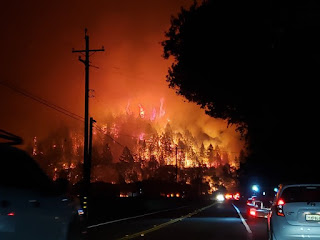This really seems to be a pattern we've fallen into: We go a long time between decent rains, and then when one finally hits, we really get nailed.
 |
| On a dark drizzly Wednesday morning after a night of heavy rain rapidly changing leaves try to brighten things up a bit im my St. Albans, Vermont yard. |
The storm system and cold front that is still going through has really over performed here in Vermont. Rainfall was unexpectedly heavy, especially from from the Green Mountains west.
About one to two inches of rain had been forecast. Instead, I'm confident that there will be isolated totals of up to four inches. Many areas certainly got more than two inches.
It was still raining at 7 a.m., though the heaviest rain was moving on at the time.
As of 7 a.m. Montpelier reported 3.31 inches. Morrisville had gotten 2.38 inches. Burlington was just shy of two inches. My unofficial rain gauge in St. Albans, Vermont collected 2.7 inches.
As of 6 a.m., flood advisories were up for the southern two counties of Vermont, where just under four inches of rain was reported in the southern tip of the state, up in the Green Mountains.
This storm would have probably caused some flooding had soil moistures and river levels been normal ahead of the storm. For the second time in less than two months, weeks of dry weather preceding a super wet storm prevented high water. In early August, Tropical Storm Isaias dumped two to four inches of rain on western Vermont.
Even with the preceding droughts, the downpours, especially the heavier ones in the pre-dawn hours, probably caused some minor damage to dirt roads and gravel driveways.
This all was caused by deep tropical moisture riding northward along a very slow moving cold front crossing Vermont. It usually takes under four hours for a cold front to pass through Vermont.
This cold front reached the northwest corner of Vermont early Tuesday afternoon. The front didn't cross the Connecticut River into New Hampshire until around 6:30 or 7 a.m today.
This slow movement left plenty of time for the downpours to linger over Vermont overnight and early this morning.
Ahead of the cold front, strong southerly winds are causing power outages in the eastern half of New England. These winds affected Vermont, too, mostly in the southern part of the state. About 6,000 homes and businesses in Vermont were without electricity as of 8 a.m. today, mostly south and east of a Rutland to St. Johnsbury line.
Lighter rains will continue off and on today, so that will be good for the still dry groundwater. One big rain storm like this is not nearly enough to erase a drought. It certainly helps, but we'll need rainy weather for the rest of the autumn to get things back on track.
Some more rain is likely Friday, but there won't be blockbuster totals like we got last night. That one will amount to a half inch of rain or less.
Early indications are that after a cool weekend, we might return to warmish weather and a return to drier than average weather as we head into the second week of October.























